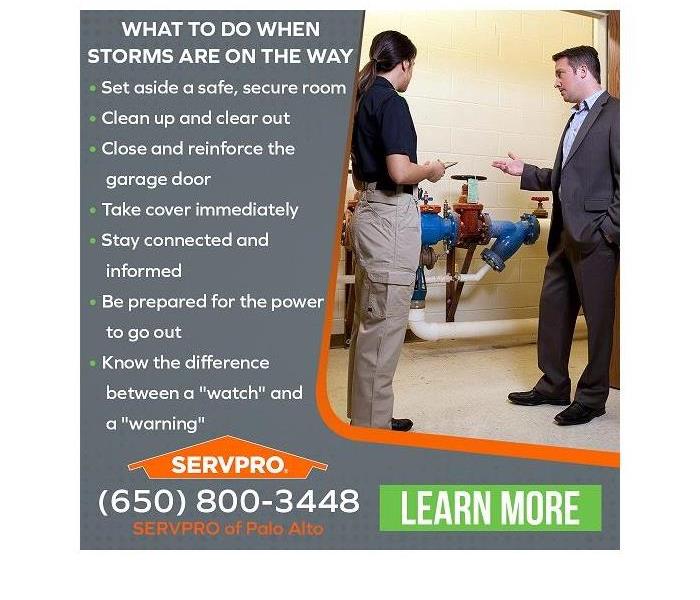Preparing for Storm Damage When the Storm Is About to Strike
11/24/2022 (Permalink)
Blog Summary: SERVPRO of Palo Alto provides helpful tips on how to prepare when severe weather and heavy thunderstorms are imminent.
A thunderstorm can pop up in what seems to be only minutes, leaving little time for preparation to prevent storm damage. Seconds count when severe weather is barreling down on a community of homes and businesses. These quick, easy-to-follow tips will help the homeowner get ready for the onslaught of heavy rain, hail, and high winds.
Tip #1. Set aside a safe, secure room.
The first and most important step to take occurs before any danger is on the horizon. This step involves designating an area or room in the home as a ‘safe room.’ Look for the following features which qualify a room or area as safe:
- The room has no windows. Window panes can break under the stress of high winds or from impact from airborne debris. Flying shards of glass can cause serious injuries, including cuts, bruises, and eye injuries. The pain, shock, and loss of eyesight can hinder escape and rescue once the storm has passed.
- The room needs to be near the center of the home. The exterior walls provide protection and support. A closet or bathroom usually meets these criteria.
- The room is located on the lowest level of the structure, preferably in the basement.
- An old-fashioned storm cellar or a reinforced concrete enclosure is a great option.
Tip #2. Clean up and clear out.
Clean out the garage so vehicles, lawn furniture, a grill, and garbage cans can be quickly moved or rolled into the space. If time permits, move these and other items into the garage.
The room selected as the location in which to barricade during severe weather may need to be cleaned up and cleared out. A few garbage bags of debris, old clothes, and junk can make enough room to save lives. Remove lamps, ceramics, glass, and other breakables from the designated safe room. Store emergency supplies and the first aid kit inside the safe room.
Tip #3. Close and reinforce the garage door.
If time permits, collect and store lawn furniture, grills, bikes, plastic toys, and garbage cans in the garage. If the garage is full, take some of the items in the house. Close the garage door and install bracing to protect against collapse under the force of high winds. Failure to close the garage door or the collapse of the door during high winds can result in catastrophic structural damage to the home.
Tip #4. Take cover immediately.
Do not wait for the brunt of the storm to arrive. Shelter in a safe room under mattresses, under a table, or beside a heavy piece of furniture with a low center of mass. This type of furniture is not easily toppled. Use the arms to cover the neck and head from flying or falling debris.
Tip #5. Stay connected and informed.
Connectedness and current information are crucial for safety and survival before, during, and after severe weather. Create a communication action plan with multiple backups. Knowledge of weather patterns and looming danger can save lives. The use of electronics that have been plugged into an outlet increases the risk of electrocution. Use a cell phone or invest in a weather radio that can operate on electricity generated by a hand crank.
Stay connected on social media outlets such as NOAA’s Storm Prediction Center (SPC). Enable wireless emergency alerts on everyone’s cell phones. The National Weather Service broadcasts emergency alerts.
Tip #6. Be prepared for the power to go out.
Anticipate power outages and prepare accordingly. Charge devices to keep the lines of communication open with family members and emergency personnel. Switch devices to low battery mode. Store the devices in a dry, safe location during the storm. Keep an ample store of fresh batteries to fit different needs. AA, AAA, C, and D batteries should be included in the supply kit. A heavy-duty, long-lasting battery backup will prove beneficial during a long-term power outage. A small gas-powered generator or power inverter is relatively affordable and can sustain a family for days with a modest supply of fuel.
Tip #7. Know the difference between a ‘watch’ and a ‘warning.’
Confusion between a ‘watch’ and a ‘warning’ can put everyone in a home a risk.
- A ‘watch’ means thunderstorms are possible, and it is time to prepare for the storm.
- A ‘warning’ means dangerous weather has been reported. Seek shelter in the safe room.
When severe thunderstorms, hail, and high winds damage a home or business, do not delay in calling a storm damage cleanup and restoration company to clean up the water and repair any damages. Homeowners and businesses can pre-qualify SERVPRO of Palo Alto as the go-to provider before a disaster strikes. With just one call, a team responds in about an hour to begin the cleanup, 27/7, 365 days a year, including holidays.
For more information about storm damage restoration, contact SERVPRO of Palo Alto by calling (650) 800-3448 or by emailing office@SERVPROpaloalto.com.



 24/7 Emergency Service
24/7 Emergency Service
